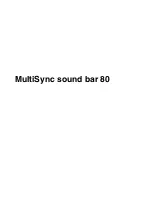
P.T.Z. (Pan, Tilt, Zoom) Configuration
If you are using a PTZ capable camera/dome
system, you can use the PC-DVR to control
the PTZ capabilities of your camera via one
of your computer’s COM ports.
Configuring a PTZ system can be a bit tricky,
so make sure you have the documentation
for your PTZ system handy when setting up
the PC-DVR - there’ll be some settings you’ll
need to get exactly right!
Please note that whilst the PC-DVR has a
full compliment of PTZ controls,
the actual
capabilities of your system will be
determined by the limitations of your
camera/dome system
. Commands which
your PTZ system cannot execute will have no
effect on your PTZ system.
Port:
Choose the port on your computer that you would
like to attach the RS485 command wires to. You can choose
any communication port (COM port) on your computer
system, control multiple PTZ systems from one COM port or
use multiple COM ports to control one or multiple cameras
simultaneously.
Many computers produced in recent years have lacked COM
ports - the uptake of USB and wireless technologies have
reduced the appeal of them, particularly in systems intended
for home or office use. However, there are a number of
possible solutions, a common one being to purchase a PCI
expansion card for your computer, which is installed in the
same manner as the PCI version of this DVR. These are quite
inexpensive, but do require some knowledge of computer
hardware to install correctly. Of course, it’s no more difficult
than installing the PCI version of the PC-DVR/
Address:
Here, enter the command address of the camera
system you want to control in association with the selected
channel. To learn/define your PTZ system’s command address,
consult your PTZ system documentation. (Typically, there are
a series of DIP switches located somewhere on the command
board.)
Protocol:
Choose the protocol as listed in your PTZ system
documentation. Choosing any other protocol will result in
the PTZ system performing poorly, or not at all.
Baud Rate:
Refers to the speed at which command data
will be sent to the PTZ system. It is important to match this
setting with your PTZ system. Some systems are not so fussy
about their baud rate, and will accept any value up to their
maximum speed. Others, however, are quite temperamental,
and will not function unless the baud rate is exactly right. This
information, much like the other settings you will configure
here, can be found in your PTZ system’s documentation.
Bit Settings:
Information sent to the PTZ system comes
in small blocks, a predetermined number of bits long with
specific codes for determining the border between packets
and error checking. The length of the data bit string, as
well as the parity is typically determined by your protocol.
However, the setting can be tweaked here.
Data Bits:
The main information contained in the command
packet are arranged into a string called ‘Data Bits’. The length
varies, but for most systems is between 8 and 24.
Parity Bit:
A form of error checking, which reduces the
chances of miscommunication between the PC-DVR and
attached PTZ system.
Stop Bit:
How many bits are used to indicate the end of a
packet. Typically, the value is “1” or “2” - however, some
protocols with more or no Stop Bits exist.
Note:
These settings will automatically be set to their defaults
for your chosen protocol. Only alter the values here if the
protocol defaults do not work correctly.
16













































